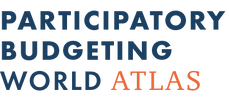about the book_
The World Atlas of Participatory Budgeting represents the widest compilation of data, to date, on the situation of these processes on the planet. This is the result of collaborative work and the enormous generosity of more than 70 authors, who voluntarily made themselves available to collect and analyse information that would enable to understand the reality of these initiatives in very diverse quadrants.One of the main motivations of this initiative is to assess the disseminator outreach of Participatory Budgeting and to understand the main trends, over the last 30 years, ensuring a first-level analysis on the data of each country, and in a second moment, on the different continents. On these pages, the reader will find many reasons of interest, unreleased data and surprising results. |
The methodology
|
The Indexes used on this edition
DEMOCRACY index 2018Me too? Political Participation, Protest and Democracy _ The Economist Intelligence Unit’s index of democracy, on a 0 to 10 scale, is based on the ratings for 60indicators, grouped into five categories: electoral process and pluralism; civil liberties; the functioning of government; political participation; and political culture. Each category has a rating on a 0 to 10 scale, and the overall Index is the simple average of the five category indexes. The index values are used to place countries within one of four types of regimes: Full democracies: Scores greater than 8 Countries in which not only basic political freedoms and civil liberties are respected, but which also tend to be underpinned by a political culture conducive to the flourishing of democracy. The functioning of government is satisfactory. Media are independent and diverse. There is an effective system of checks and balances. The judiciary is independent and judicial decisions are enforced. There are only limited problems in the functioning of democracies. Flawed democracies: Scores greater than 6 and less than or equal to 8 These countries also have free and fair elections and, even if there are problems (such as infringements on media freedom), basic civil liberties are respected. However, there are significant weaknesses in other aspects of democracy, including problems in governance, an underdeveloped political culture and low levels of political participation. Hybrid regimes: Scores greater than 4, and less than or equal to 6. Elections have substantial irregularities that often prevent them from being both free and fair. Government pressure on opposition parties and candidates may be common. Serious weaknesses are more prevalent than in flawed democracies - in political culture, functioning of government and political participation. Corruption tends to be widespread and the rule of law is weak. Civil society is weak. Typically, there is harassment of and pressure on journalists, and the judiciary is not independent. Authoritarian regimes: Scores less than or equal to 4. In these states, state political pluralism is absent or heavily circumscribed. Many countries in this category are outright dictatorships. Some formal institutions of democracy may exist, but these have little substance. Elections, if they do occur, are not free and fair. There is disregard for abuses and infringements of civil liberties. Media are typically state-owned or controlled by groups connected to the ruling regime. There is repression of criticism of the government and pervasive censorship. There is no independent judiciary. Economist Intelligence Unit (2019). Democracy index 2018: Me too? Political Participation, Protest and Democracy. |
HUMAN DEVELOPMENT index 2018The Human Development Index (HDI) is a composite index focusing on three basic dimensions of human development: the ability to lead a long and healthy life, measured by life expectancy at birth; the ability to acquire knowledge, measured by mean years of schooling and expected years of schooling; and the ability to achieve a decent standard of living, measured by gross national income per capita. To measure human development more comprehensively, the Human Development Report presents four other composite indices. The Inequalityadjusted HDI discounts the HDI according to the extent of inequality. The Gender Development Index compares female and male HDI values. The Gender Inequality Index highlights women’s empowerment. And the Multidimensional Poverty Index measures non income dimensions of poverty. UNDP (2018). Human Development Indices and Indicators 2018: Statistical update, UN, New York Corruption Perception Index 2018The CPI 2018 is calculated using 13 different data sources from 12 different institutions that capture perceptions of corruption within the past two years: · African Development Bank Country Policy & Institutional Assessment 2016; · Bertelsmann Stiftung Sustainable Governance Indicators 2018; · Bertelsmann Stiftung Transformation Index 2017-2018; · Economist Intelligence Unit Country Risk Service 2018; · Freedom House Nations in Transit 2018; · Global Insight Business Conditions and Risk Indicators 2017; · IMD World Competitiveness Center World Competitiveness Yearbook Executive Opinion Survey 2018; · Political and Economic Risk Consultancy Asian Intelligence 2018; · The PRS Group International Country Risk Guide 2018; · World Bank Country Policy and Institutional Assessment 2017; · World Economic Forum Executive Opinion Survey 2018; · World Justice Project Rule of Law Index Expert Survey 2017-2018 · Varieties of Democracy (V-Dem) 2018. Standardise data sources to a scale of 0-100 where a 0 equals the highest level of perceived corruption and 100 equals the lowest level of perceived corruption. Transparency International (2018). Corruption Perception Index 2018. |
World Happiness Report 2019These rankings are accompanied by our latest attempts to show how six key variables contribute to explaining the full sample of national annual average scores over the whole period 2005-2018. These variables are GDP per capita, social support, healthy life expectancy, freedom, generosity, and absence of corruption. Note that we do not construct our happiness measure in each country using these six factors - the scores are instead based on individuals’ own assessments of their lives, as indicated by the Cantril ladder. Rather, we use the six variables to explain the variation of happiness across countries. We shall also show how measures of experienced well-being, especially positive affect, supplement life circumstances in explaining higher life evaluations Helliwell, J., Layard, R., & Sachs, J. (2019). World Happiness Report 2019, New York: Sustainable Development Solutions Network. |
Countries’ Population 2018Demographic estimates for each country were obtained from the following World Bank database. |





